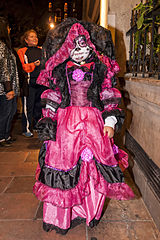La Calavera Catrina

La Calavera Catrina or Catrina La Calavera Garbancera ('Dapper Skeleton', 'Elegant Skull') is a 1910–1913 zinc etching by the Mexican printmaker, cartoon illustrator and lithographer José Guadalupe Posada.[1] La Catrina has become an icon of the Mexican Día de Muertos, or Day of the Dead.
Cultural importance[]

"La Catrina has become the referential image of Death in Mexico, it is common to see her embodied as part of the celebrations of Day of the Dead throughout the country; she has become a motive for the creation of handcrafts made from clay or other materials, her representations may vary, as well as the hat." – J.G. Posada[2]
While the original work by Posada introduced the character, the popularity of La Calavera as well as her name is derived from a work by artist Diego Rivera in his 1947 completed mural Sueño de una Tarde Dominical en la Alameda Central (Dream of a Sunday afternoon along Central Alameda).
Rivera's mural was painted between the years 1946 and 1947, and is the principal work of the "Museo Mural Diego Rivera" adjacent to the Alameda in the historic center of Mexico City. It measures 15 meters long and it stood at the end of Alameda Park. The mural survived the 1985 earthquake, which destroyed the Del Prado hotel, and was later moved across the street to the Museo Mural Diego Rivera, built after the earthquake for the purpose of housing and displaying Rivera's restored mural.[3]
Artistic subtext[]
Image[]
Rivera's mural depicts a culmination of 400 years of Mexico's major figures, which include himself, Posada, and Frida Kahlo. Rivera took inspiration from the original etching and gave Calavera a body as well as more of an identity in her elegant outfit as she is poised between himself and Posada.
Culture[]
The culture of La Calavera has ties to political satire and is also a well-kept tradition as the original was inspired by the polarizing reign of dictator Porfirio Díaz. Díaz is lauded for modernizing and bringing financial stability to Mexico, but he also led his government in repression, corruption, and excess, and had an apparent obsession with European materialism and culture. Christine Delsol writes: "Concentration of fantastic wealth in the hands of the privileged few brewed discontent in the hearts of the suffering many, leading to the 1910 rebellion that toppled Diaz in 1911 and became the Mexican Revolution."[3]
Folk art[]
Purist[]
La Calavera Catrina today can be found in her more traditional form both in drawn works as well as sculptures made out of Oaxacan wood carvings, papier-mâché sculptures, majolica pottery, and Barro negro black clay pottery. She is also coupled with male skeletons.
Costume[]
Dressing as a "Catrina" is a popular costume in Day of the Dead celebrations in Mexico. Catrinas typically feature "sugar skull" make-up.[4]
- Day of the Dead, circa 2014.

Woman dressed as a Catrina

Girl dressed as a Catrina

A Catrina

Three children dressed as Catrinas

Woman dressed as a Catrina
Gallery[]

A Catrina inspired by María Félix as part of an ofrenda on the day of the dead festivities at San Ángel in November 2014

A Catrina inspired by Selena during celebrations of Day of the Dead at Hollywood Forever Cemetery, Los Angeles

Center of Diego Rivera's wide mural Sueño de una Tarde Dominical en la Alameda Central (Dream of a Sunday Afternoon in the Alameda Central)

Modern representations of Catrina at the Museo de la Ciudad, León, Guanajuato, Mexico

Image done in colored sawdust for Día de Muertos

Detail of a Catrina figure in Barro negro pottery by artisan Carlomagno Pedro Martinez
La Catrina in China Poblana dress, by Rodofo Villena Hernandez in Puebla
See also[]
- All Saints Day
- Danse Macabre
- Day of the Dead
- Death (personification)
- Ghosts in Mexican culture
- Memento mori
- Santa Muerte
- Skeleton (undead)
References[]
- ^ "Jose Guadalupe Posada, Calavera Catrina (Dapper Skeleton)". ArtofthePrint.com.
- ^ "La Catrina – The woman of Mexico". Rocky Point 360. 2012-10-30. Retrieved 2018-10-27.
- ^ a b Delsol, Christine; SFGate, Special to (25 October 2011). "La Catrina: Mexico's grande dame of death". SFGate.
- ^ Devash, Meirav. "5 Things to Know Before Doing Dia de Los Muertos Makeup". Allure. Retrieved 2018-10-07.
External links[]
![]() Media related to La Calavera Catrina at Wikimedia Commons
Media related to La Calavera Catrina at Wikimedia Commons
- Mexican culture
- 1913 works
- 20th-century etchings
- Fictional skeletons
- Holiday characters
- Mexican art
- Personifications of death
- Skulls in art










